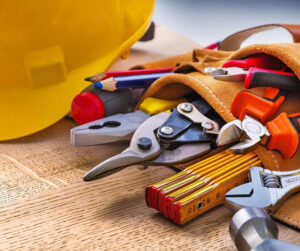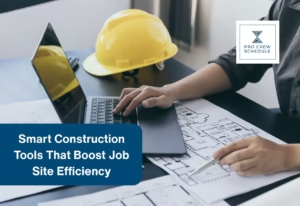Time is of a great essence in the construction industry. Miss out on your set builders schedule and you will end up submitting the project delayed. But thanks to technology, practical solutions have been made available so that construction companies will surely meet their schedule including the use of BIM, project management software, automated machineries and equipment, and power tools.
Power tools and equipment are important in construction. They have revolutionized the industry and streamlined most processes in construction sites. As you know, most of the tasks in construction are manual and some are too heavy to accomplish with just the bare hands. The transport and positioning of corrugated bars for instance. Without a crane, it will take forever to finish this task. Mixing cement is another. Without the cement mixer equipment that we have today, cement mixing will be so exhausting, considering the fact that most projects today need tons of concrete mixture.
But despite their importance, power tools and equipment are often the most neglected assets in construction. They are overworked yet unmaintained. They are expensive yet neglected.
In a project, construction companies can spend up to $182,000 on buying equipment and $132,000 on rent. Yet they spend another hundred thousand dollars to buy power tools. So, just imagine how much money is wasted every year when tools and equipment are not handled well at the site. But despite the losses on tools and equipment, companies are still inclined to invest in buying and renting because they offer:
- Higher productivity
- Worker safety
- Worker efficiency
- Higher speed
- Accurate and quality work
- Timely completion of projects
- Reduced manpower
- Cost effectiveness
Buying vs Renting Tools and Equipment
Tools are more affordable to buy than equipment. One complete set of construction crew tools may only cost $2000-$5000 depending on the brand you choose. But when it comes to equipment, companies need to do a lot of thinking before deciding on whether to buy or rent out one.
For startups, renting can be the better choice. However, you will be given conditions on wear and tear so it is wise to hire from a supplier whose equipment is insured. Replacing damaged equipment can put your savings down the drain so before signing a contract with a supplier check on their rental policy if they include insurance.
Buying is the best solution for companies that are already well established and have numerous projects lined up. They can later put them on sale before they totally wear out or when they need to upgrade.
Either way, maintenance should be a part of tools and equipment handling in construction. This is to prolong their lives so that you can benefit from them for a longer time before they become useless.
Construction Tools and Equipment Maintenance
Heavy machinery and equipment in construction always require constant maintenance to keep them in good working condition. it in good working order. On the other hand, poorly maintained equipment can cause inefficiency and troubles at the site more than it can help. Malfunctioning can even cause accidents at the site. The same goes for construction power tools. Breakdowns are costly so here are tips on how to properly maintain your construction equipment, machine, and power tools.
I- Construction Equipment Maintenance
- Conduct Machinery Operator Training
The first step to good machine maintenance practice is learning how to properly use it. Modern machines are especially complicated for an old crew to operate. Most machines are now automated and some have computer boxes to control them. That said, it would be best to train an operator first on the proper use of the machines before letting him handle them.
It should also be a standard operating procedure to inspect a machine when it’s purchased. Most dealers will give a free orientation on how to operate the machine and some even offer to train your crew for free. Take that opportunity to teach your operators as no one knows the machine you’re purchasing better than the dealer.
See to it that you share the operator manual to your assigned crew member so that he can have a ready reference when he forgets something. If you feel like the manual is too technical for your operator to understand then go the extra mile to rewrite it in simpler language. You can also save them on your construction crew management software so the operators won’t need to bring along printed manuals that can easily be destroyed and misplaced and cause extra clutter at the site.
And apart from teaching them how to operate the machine, an important part of the training should be teaching them how to maintain such valuable investment.
- Add Lubricants Frequently
Construction machines and equipment are mechanical and they have a lot of moving parts in them. These parts create a lot of friction that may cause overheating, breakdowns, and explosion. To prevent that from happening, you should schedule lubrication maintenance to prolong the life of the machine and its parts.
However, you should use the right type of lubrication. Some parts of the machine need a specific kind of oil or grease. Always refer to the user manual to find out which types are best to use.
When doing lubrication maintenance, also add in your routine the checking for leaks. You will see that around the oil seals of the machines. They should be dry. Otherwise, there are leaks and that means your moving parts are bound to overheat.
Check your lubrication tanks for contaminants too. Unwanted particles can clash with some sensitive parts of the machine and it’s likely to suffer from wear or breakdown.
- Check for Signs of Wear
Machines often do the heaviest job in construction so it’s no longer a surprise when you notice some signs of wear. They are most likely caused by vibration, friction, age, high temperature, and shock. It’s normal but don’t neglect these signs of wear.
When you notice cracks, dents, holes, and other damages, have the heavy equipment checked by a mechanic. Schedule regular inspections to see if any parts already need replacement.
- Clean Machines and Keep them In Clean Environment
Treat your machines like luxury cars that need to be cleaned and kept in a safe and clean garage. In fact, some machines are even pricier than a Ferrari.
We mentioned earlier that contaminants can destroy a machine. This is especially true for equipment used in processing cement, concrete, wood, and other raw materials that may leave particles behind. They can damage parts of your machines, most especially the gears and electronics.
That said, it should be an SOP to clean the surfaces of your machine every after usage. Deep cleaning should also be scheduled every month to make sure that the machines are in good condition. Filters should be changed regularly.
And during their downtime, machines should be stored in a shed that will prevent them from being exposed to wind, rain, and sun that may cause them to rot or rust.
- Schedule and Record Repairs
Assign a day in a month when you’ll let a mechanic check on your equipment. Check your builders schedule when the best day in a month will be to do the repairs so that you won’t need to compromise your deadlines.
Several components should be checked in a machine like the fluids, electrical systems, engine, power transmissions, seals, gaskets, bearings, bolts, belts, tires, and others.
When repairs are done, be sure to make a record of them so you’ll know how to handle the machine the next time it breaks down. This also gives you an idea when you should be replacing parts and fuels. You can save them in your project management software so you can check on the record anytime. You can even set alerts so that you are reminded when the next preventive maintenance should be.
II – Construction Tools Maintenance
Just like machines and equipment, power tools used in construction are also costly and are not wear and tear-resistant. That said, here are some tips on how you can prolong their lives:
- Store Power Tools Properly
Have a proper and safe storage for all power tools. For instance, set up a room where all power tools can be organized and stored and assign a custodian to issue the tools to your crew members. Have the custodian record the borrower’s name and purpose too. This way, you can prevent your costly tools from being misplaced.
Provide toolboxes too so they won’t have to carry the tools by bare hands that can cause injuries when accidents suddenly happen.
- Replace Consumables Regularly
Some power tools use consumable parts that need to be replaced regularly like drill bits and blades. B sure to replace them before they wear out on your power tools as it may contribute to the wearing of your tool. It is recommended to replace them when they are already about 75 percent of their life cycle.
- Clean Power Tools Everyday
Unlike machines, power tools are easier to clean so oblige your crew members to clean them before they submit them back to the custodian. Teach them how to properly clean the tools as some have sensitive parts that may easily break when touched carelessly.
Use vacuum or air compressors to wipe out particles that are stuck between small spaces within the power tool. If the tool needs a special paraphernalia for cleaning then provide them that.
- Don’t Overcharge Batteries
Most power tools today are cordless and battery operated. When recharging be sure to follow the recommended time for charging to maintain the battery’s life. Don’t charge the tool when the battery is still half full. Don’t drain the battery before charging. Leave at least 10% of the battery charge before you start recharging. And don’t undercharge too as it will require you to recharge more often.
- Create Checklists for Proper Tool Handling
As we mentioned, construction sites can be hectic so your crew members are bound to forget a couple of things like how they should handle the power tools they use in their tasks. And with so many kinds of tools that are used in construction, your workers may be confused at times. To prevent them from using the tools incorrectly, you can create a checklist or summarize instructions and save them on your construction crew management so they can easily refer to them when needed.
Conclusion
Following the 10 steps we listed above, you can significantly extend the life of your equipment, heavy machines, and power tools. Remember that tools and equipment used in construction are expensive investments so ensure that they are in their top condition by maintaining them regularly and doing repairs when needed.





